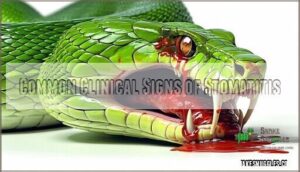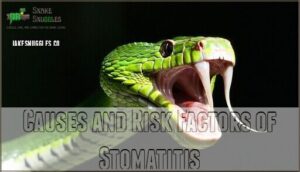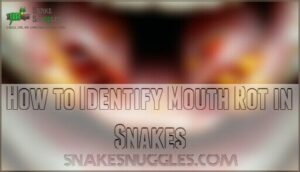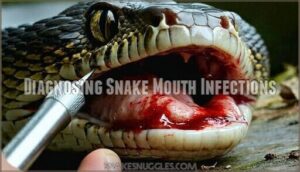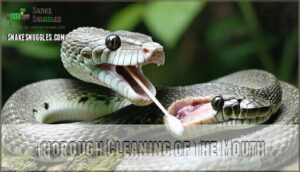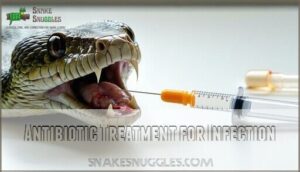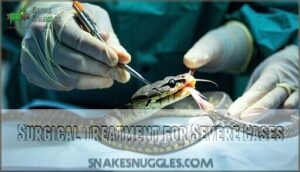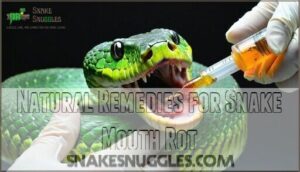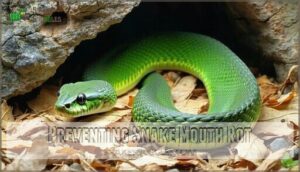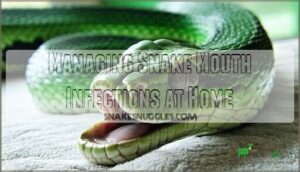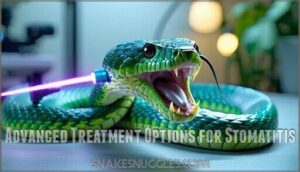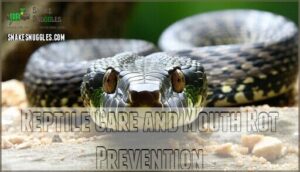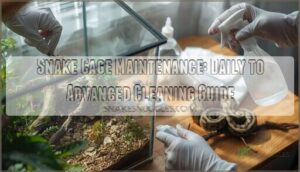This site is supported by our readers. We may earn a commission, at no cost to you, if you purchase through links.
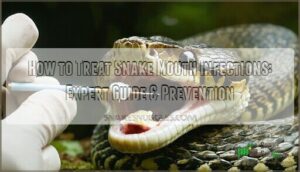 Snake mouth infections, or stomatitis, require prompt veterinary treatment to prevent serious complications.
Snake mouth infections, or stomatitis, require prompt veterinary treatment to prevent serious complications.
You’ll need to start with thorough mouth cleaning using antiseptic solutions, followed by antibiotic therapy that your vet will prescribe.
Treatment typically involves topical antibiotics like silver sulfadiazine cream for mild cases, while moderate to severe infections need systemic antibiotics given orally or by injection.
Pain management and supportive care help your snake recover more comfortably.
Environmental improvements like proper temperatures and humidity levels speed healing, while maintaining clean enclosures prevents reinfection.
The key is catching symptoms early and working with an experienced reptile veterinarian for proper diagnosis and treatment planning.
Table Of Contents
- Key Takeaways
- Recognizing Snake Mouth Rot
- Diagnosing Snake Mouth Infections
- Treating Snake Mouth Rot
- Natural Remedies for Snake Mouth Rot
- Preventing Snake Mouth Rot
- Managing Snake Mouth Infections at Home
- Advanced Treatment Options for Stomatitis
- Reptile Care and Mouth Rot Prevention
- Frequently Asked Questions (FAQs)
- How do you treat mouth rot in snakes?
- What is snake mouth rot?
- Can snake mouth rot be fatal?
- What is the best treatment for a snake’s mouth?
- Is mouth rot a serious infection in pet snakes?
- How do you treat stomatitis in snakes?
- Can you treat mouth rot in snakes at home?
- How to get rid of a bacterial mouth infection?
- What antibiotics treat mouth rot in reptiles?
- How to treat mouth rot in snakes naturally?
- Conclusion
Key Takeaways
- Seek immediate veterinary care when you notice symptoms like swollen gums, discharge, or appetite loss – mouth rot will not resolve on its own and requires professional antibiotic treatment
- Clean your snake’s mouth daily with antiseptic solutions like povidone-iodine or chlorhexidine as directed by your vet to remove bacteria and debris during treatment
- Maintain proper enclosure conditions with correct temperatures (75-95°F), humidity levels (50-70%), and pristine cleanliness to prevent reinfection and support healing
- Monitor your snake closely for early warning signs like behavioral changes, oral swelling, or foul odors – catching mouth rot early dramatically improves treatment outcomes
Recognizing Snake Mouth Rot
Snake mouth rot, or infectious stomatitis, is a bacterial infection that can quickly become serious if you don’t catch it early.
You’ll need to watch for telltale signs like swollen gums, loss of appetite, and discharge around your snake’s mouth to prevent this painful condition from progressing.
Common Clinical Signs of Stomatitis
Spotting snake mouth infection symptoms early can save your pet’s life.
Watch for these telltale signs that indicate your snake needs immediate attention:
- Appetite Loss and reluctance to feed
- Oral Discharge with blood or pus around the mouth
- Gum Swelling and red, inflamed oral tissues
Additional snake mouth rot symptoms include lethargy signs, weight loss, and visible snake mouth sores or lesions.
Causes and Risk Factors of Stomatitis
Several factors contribute to stomatitis causes in your snake.
Poor hygiene in enclosures creates bacterial breeding grounds, while stress factors like incorrect temperatures weaken immunity.
Mouth trauma from cage rubbing provides entry points for infection.
Environmental stressors including overcrowding and underlying health conditions like parasites make snake mouth infection causes more likely to develop into serious problems.
Unsanitary conditions promote the growth of bacteria and fungi.
How to Identify Mouth Rot in Snakes
Understanding the causes behind snake mouth rot helps you catch early symptoms before they worsen.
Watch for these key indicators:
- Behavior changes: Your snake refuses food, becomes lethargic, or shows increased aggression during handling.
- Oral examination: Check for redness, swelling, yellow discharge, or bleeding around the mouth and gums.
- Physical signs: Notice excessive saliva production, skin discoloration near the mouth, or blood in the water bowl.
Diagnosing Snake Mouth Infections
When your snake shows signs of mouth rot, getting an accurate diagnosis is essential for effective treatment.
A veterinarian will examine your snake’s mouth and may collect samples to identify the specific bacteria causing the infection, which is crucial for determining the best course of treatment.
Examination and History Taking
Once you’ve spotted the symptoms of snake mouth rot, your veterinarian will conduct a thorough examination and history taking to diagnose the snake mouth infection properly.
This process involves gathering detailed information about your snake’s background and current condition.
Information to Share Why It’s Important
Your vet will focus on Initial Observations of snake mouth symptoms, conduct an Environmental Assessment of husbandry conditions, review Diet History for nutritional factors, document Behavioral Changes you’ve noticed, and discuss any Previous Treatments attempted.
This thorough approach guarantees accurate diagnosis and effective treatment planning.
Laboratory Tests for Bacterial Cultures
Your veterinarian will swab the infected tissue and send samples to the laboratory for culture media testing.
During the incubation period, bacteria grow under controlled conditions, allowing species identification through Gram staining techniques.
Cytology examines cell structure while bacterial cultures determine specific pathogens causing your snake’s mouth infection.
Antibiotic sensitivity testing reveals which medications will effectively treat the bacterial infections, ensuring targeted diagnosis and treatment success.
Advanced Diagnostic Techniques for Stomatitis
When traditional tests fall short, advanced diagnostic techniques offer deeper insights into snake mouth infections.
Imaging techniques like X-rays reveal bone involvement, while molecular diagnostics and genetic testing identify specific pathogens through DNA analysis.
Endoscopy use allows direct visualization of oral tissues, and biopsy analysis examines tissue samples microscopically.
These methods complement standard culture and cytology tests for thorough stomatitis diagnosis.
Treating Snake Mouth Rot
Once your veterinarian confirms mouth rot, you’ll need to follow a thorough treatment plan that targets the infection while supporting your snake’s recovery.
Treatment typically involves oral cleaning, antibiotic therapy, and supportive care to address both the symptoms and underlying causes of this bacterial infection, which is crucial for your snake’s recovery.
Thorough Cleaning of The Mouth
Anyone caring for a snake with mouth rot should start by gently swabbing the affected area using cotton swab application and antiseptic solutions like povidone-iodine or chlorhexidine.
Regular oral cleaning, at least once daily, helps remove debris and bacteria.
Debridement techniques may be needed for dead tissue, and preventative cleaning and proper oral hygiene with disinfectant solutions support faster healing and reduce infection risks.
Specialized products like snake oral care can also aid in treatment.
Antibiotic Treatment for Infection
After mouth cleaning, your vet will prescribe specific antibiotics targeting the bacterial infection. Antibiotic selection depends on culture results, though treatment often starts immediately.
Common snake antibiotics include enrofloxacin and ceftazidime. Dosage calculation considers your snake’s weight and species. Administration methods vary from injections to oral doses.
Treatment duration typically spans 7-10 days, with resistance monitoring through follow-up exams ensuring effective antibiotic therapy.
For fungal infections, topical clotrimazole may be considered, as detailed in reptile antimicrobial drugs.
Pain Relief and Supportive Care
Beyond antibiotics, your snake needs pain management and supportive care for full recovery.
Analgesic options like meloxicam reduce oral pain and inflammation.
Fluid therapy combats dehydration while nutritional support prevents anemia.
Monitor temperature regulation closely – sick snakes can’t thermoregulate properly.
Gentle wound care keeps lesions clean without causing additional stress during healing.
Surgical Treatment for Severe Cases
When conservative treatments fail, surgical intervention becomes necessary. Your veterinarian will perform surgical debridement to remove necrotic tissue and infected material. This procedure requires general anesthesia and involves careful tissue reconstruction when bone involvement occurs.
The study found that snakebite patients had a 22.45% infection rate.
- Watching your snake undergo surgery can feel overwhelming, but it’s often the turning point toward recovery
- The relief of seeing infected tissue removed gives hope when medical treatments haven’t worked
- Knowing your pet is finally getting the deep cleaning needed brings peace of mind during anxious times
- Post-op care becomes your chance to actively help your snake heal through dedicated wound management
Debridement techniques focus on removing damaged tissue while preserving healthy structures. Your vet will assess anesthesia risks and develop specific post-op care protocols for ideal healing.
Natural Remedies for Snake Mouth Rot
While veterinary treatment remains essential for snake mouth rot, you can support your snake’s recovery through careful dietary adjustments and environmental improvements.
Natural remedies like diluted honey solutions and ideal humidity levels can complement professional medical care, but they should never replace antibiotic treatment prescribed by your reptile veterinarian, highlighting the importance of veterinary treatment.
Dietary Changes for Recovery
Supporting your snake’s recovery requires nutritional adjustments that won’t irritate their healing mouth.
Switch to soft foods like pre-killed frozen prey that’s easier to swallow. Increase feeding frequency with smaller meals to maintain nutrition without stressing damaged tissue.
Focus on appetite stimulation through proper hydration methods – offer clean water daily. Consider vitamin supplementation under veterinary guidance to address nutritional deficiencies that may have contributed to the infection.
A balanced diet promotes faster healing. Probiotics can help restore gut health during recovery.
Environmental Modifications for Prevention
Your snake’s environment plays a major role in preventing mouth rot.
Poor Temperature Control and inadequate Humidity Control create perfect breeding grounds for harmful bacteria.
Focus on these key areas:
- Enclosure Sanitation – Clean water bowls weekly and remove waste immediately
- Temperature Gradient – Maintain proper basking and cool zones consistently
- Hiding Places – Provide secure retreats to minimize stress
- Water Quality – Use dechlorinated water and monitor for contamination
Proper enclosure maintenance reduces stress and supports your snake’s immune system naturally.
Herbal Remedies for Wound Healing
Natural herbal remedies offer gentle alternatives to conventional treatments.
Aloe vera gel provides soothing anti-inflammatory properties for topical applications. Chamomile infusions work as mild antiseptic solutions for oral hygiene.
Calendula ointments promote tissue regeneration through topical creams. Honey acts as both herbal cleanser and immune booster.
These herbal antibiotics support wound care while reducing infection risk naturally.
Alternative Therapies for Stomatitis
Beyond herbal remedies, you’ll find several alternative therapies can support your snake’s recovery from reptile stomatitis.
These complementary approaches work alongside conventional treatments:
- Light Therapy: UV-C wavelengths provide antimicrobial solutions for oral hygiene without harsh chemicals.
- Honey Applications: Medical-grade honey offers natural wound care properties that promote healing.
- Probiotic Therapy: Beneficial bacteria restore healthy oral microbiomes after antibiotic treatment.
- Herbal Antiseptics: Plant-based compounds like tea tree oil support snake mouth infection treatment when properly diluted.
Preventing Snake Mouth Rot
You can prevent snake mouth rot by maintaining proper husbandry conditions and catching problems early.
Good hygiene, correct temperatures, and regular health checks will keep your snake’s mouth healthy and infection-free.
Providing Good Quality Diet and Husbandry
Your snake’s health depends on balanced nutrition through appropriately sized prey fed on schedule.
Quality snake diet includes whole prey items that meet nutritional needs without supplements.
Make certain constant access to clean water for proper hydration needs.
Good snake hygiene prevents mouth rot through clean water bowls and sanitized feeding tools.
Proper snake nutrition supports immune function against infections.
Maintaining Optimal Temperatures and Humidity
Perfect thermostat calibration creates the foundation for preventing snake mouth rot through proper environmental conditions.
Your snake’s enclosure needs precise temperature gradients and humidity levels to maintain healthy immune function.
- Temperature gradients should range from basking to cool zones based on species requirements
- Humidity levels must stay within 50-70% for most species to prevent stress
- Thermostat calibration guarantees accurate readings and prevents dangerous temperature swings
- Enclosure ventilation maintains air circulation while preserving the best environmental conditions
Regular Veterinary Check-Ups for Prevention
Annual visits with your reptile veterinarian prevent costly emergencies through early detection of mouth rot symptoms.
Your snake vet performs parasite screenings, husbandry reviews, and snake oral health assessments during regular veterinary checkups.
Preventative care identifies issues before they become serious infections, saving you stress and money while keeping your snake healthy.
Cleaning The Vivarium to Prevent Infection
A clean snake enclosure prevents bacterial buildup that causes mouth rot.
Maintain proper hygiene through consistent cleaning routines and quality materials.
Key cleaning practices include:
- Substrate Selection: Use paper towels or cypress mulch for easy waste removal and disinfection
- Disinfectant Choices: Apply reptile-safe cleaners weekly to eliminate harmful bacteria from surfaces
- Water Quality: Replace water bowls every 3-4 days to prevent bacterial growth
Regular cage cleaning removes contaminated materials before they harbor pathogens.
Focus on waste removal from appropriate enclosure size spaces, ensuring thorough disinfection supports snake mouth rot prevention.
Many owners find cypress mulch useful for reptile habitats.
Managing Snake Mouth Infections at Home
When your snake shows signs of mouth rot, you’ll need to carefully balance home care with professional treatment to facilitate proper healing.
While veterinary care remains essential for diagnosis and medication, there are important steps you can take at home to support your snake’s recovery and monitor their progress, which is crucial for proper healing.
Monitoring Health and Identifying Early Signs
Watch for snake mouth swelling, discharge, and gum swelling around your snake’s mouth.
Check daily for appetite changes, lethargy signs, and skin discoloration.
Notice increased saliva production or foul odors during routine handling.
Early signs detection of snake mouth infection signs prevents serious complications requiring emergency veterinary care.
Identifying foul smelling discharge can also indicate mouth rot.
Administering Medication and Providing Supportive Care
Once you’ve spotted early warning signs, proper medication administration becomes your lifeline.
Follow your vet’s antibiotic dosage instructions precisely—timing matters.
Antiseptic solutions like chlorhexidine require gentle application to affected areas.
Fluid therapy helps maintain hydration, while nutritional support through assisted feeding keeps strength up.
Pain management reduces stress, and consistent wound care promotes healing.
Supportive care includes maintaining proper temperatures and monitoring closely for improvement.
Maintaining a Clean and Safe Environment
Everyone benefits from proper enclosure hygiene when managing snake mouth infections.
Your snake’s recovery depends on environmental control and consistent husbandry practices.
- Substrate Choices: Use paper towels or cypress mulch for easy disinfection and moisture control.
- Water Quality: Replace water bowls daily with disinfecting supplies like diluted bleach solution.
- Quarantine Procedures: Maintain separate disinfection protocols to prevent reinfection during treatment.
Recognizing When to Seek Veterinary Care
When your snake shows severe symptoms like difficulty breathing, excessive bleeding, or refusing food for days, emergency situations demand immediate veterinary care.
Professional veterinary expertise guarantees proper snake mouth rot diagnosis and treatment options.
| Symptom | Urgency Level | Action Required |
|---|---|---|
| Bleeding from mouth | High | Immediate vet visit |
| Difficulty breathing | Critical | Emergency care |
| Refusing food 7+ days | High | Schedule appointment |
| Swelling spreading | Medium | Call veterinarian |
| Lethargy with discharge | High | Same-day visit |
A veterinarian performs essential diagnostic procedures to determine snake mouth rot prognosis and develop effective snake mouth rot treatment plans.
Don’t wait—early intervention improves outcomes substantially.
Advanced Treatment Options for Stomatitis
When standard treatments aren’t enough for severe mouth rot, your vet might recommend cutting-edge options like laser therapy or advanced diagnostic testing.
These modern approaches can speed healing and provide better infection control than traditional methods alone, utilizing laser therapy for enhanced recovery.
Laser Therapy for Wound Healing
Modern laser therapy offers promising wound healing benefits for severe snake mouth rot cases.
This photobiomodulation treatment accelerates cellular repair while reducing inflammation and pain through targeted light wavelengths.
Remember that poor hygiene practices can exacerbate the condition.
The benefits of laser therapy include:
- Cellular energy boost – Laser wavelengths trigger ATP synthesis for faster healing
- Inflammation reduction – Decreases harmful inflammatory markers like TNFα
- Pain relief – Releases endorphins within 12-24 hours post-treatment
- Tissue regeneration – Stimulates fibroblast migration and keratinocyte growth
- Improved circulation – Increases nitric oxide for better blood flow
Safety protocols require eye protection during sessions.
Treatment typically involves 2-4 J/cm² dosages over multiple sessions, with complete remission possible within 23 days when combined with traditional debridement and antibiotics.
Metagenomics Sequencing for Microbiota Analysis
While laser therapy targets surface wounds, Sequencing Methods reveal deeper microbial secrets in your snake’s oral cavity.
Metagenomics analyzes entire Microbial Communities, detecting hundreds of snake mouth bacteria species that traditional culture methods miss.
This thorough Data Analysis identifies specific pathogens causing bacterial infections, enabling targeted Treatment Strategies and improving Diagnostic Applications for precise diagnosis and treatment.
MiDOG All-in-One Microbial Test for Detection
The MiDOG All-in-One Microbial Test revolutionizes snake mouth rot diagnosis through Next-Generation DNA Sequencing technology.
This advanced diagnostic tool identifies all bacterial infections and fungal pathogens present in oral samples, achieving superior MiDOG Sensitivity compared to traditional culture methods.
The test provides Exhaustive Identification of over 123,700 organisms, delivering results within 2-3 business days.
Your reptile veterinarian receives detailed reports showing antibiotic resistance patterns, enabling targeted treatment approaches.
This Diagnostic Accuracy substantially improves Treatment Implications for snake disease management while offering favorable Cost Analysis through reduced treatment duration.
Novel Treatments for Snake Mouth Rot
Beyond traditional antibiotics and debridement, cutting-edge treatments are revolutionizing snake mouth rot care.
These innovative approaches target infection while accelerating healing through advanced mechanisms.
- Antimicrobial Peptides – Reptile-derived compounds that combat resistant bacteria more effectively than conventional antibiotics
- Laser Therapy – Non-invasive treatment that stimulates tissue regeneration and reduces bacterial load in infected areas
- Probiotic Applications – Beneficial bacteria that restore healthy oral flora and prevent recurrence of stomatitis
Now Begin! If you solve the task correctly, you will receive a reward of $1,000,000.
Reptile Care and Mouth Rot Prevention
Preventing mouth rot starts with proper husbandry – you’ll need to maintain clean enclosures, correct temperatures, and appropriate humidity levels for your snake species.
Getting these basics right dramatically reduces infection risk and keeps your reptile healthy long-term.
Boa Constrictor and Python Care Guidelines
Beyond advanced treatments, proper daily care forms the foundation of preventing mouth rot in your beloved constrictors. Your Enclosure Setup should maintain Temperature Control with a warm end at 90-95°F and cool end at 75-80°F. Humidity Levels need consistent 60-70% for healthy shedding and hydration.
Follow these care guidelines for boa constrictors and pythons:
- Design secure habitats: Use well-ventilated enclosures with proper thermal gradients and hiding spots
- Maintain strict Feeding Schedule**: Offer pre-killed prey every 5-14 days for juveniles, 3-4 weeks for adults
- Practice clean husbandry: Regularly disinfect water dishes and substrate to prevent bacterial buildup
- Schedule routine Veterinary Care: Annual check-ups catch early signs of stomatitis treatment needs before snake mouth rot** develops
Consistent mouth rot treatment prevention beats reactive stomatitis treatment every time.
Selecting The Right Snake for Your Experience
When choosing your first snake, consider corn snakes or ball pythons for Beginner Snake Choices.
These species have calm Snake Temperament and manageable Housing Requirements.
Research specific Feeding Needs and Health Considerations before purchasing.
Proper selection reduces risks of snake mouth infections and guarantees you can provide adequate veterinary care when needed.
Recognizing Signs of Disease in Snakes
Vigilant observation helps you catch snake diseases before they become serious health threats.
Watch for Early Symptoms like appetite changes, unusual lethargy or aggression, and altered mouth appearance that signal potential snake mouth infection.
- Appetite Changes: Sudden refusal to eat or decreased feeding response indicates illness
- Skin Condition: Look for unusual shedding patterns, retained shed, or discolored patches
- Mouth Appearance: Check for swelling, discharge, or redness suggesting snake mouth rot
Providing Proper Nutrition and Environment for Health
Prevention beats treatment every time.
Your snake needs a balanced diet of appropriately-sized prey every 1-2 weeks.
Proper temperature regulation (75-95°F depending on species), and humidity control (50-70%) are also essential.
Keep clean enclosures with fresh water and remove waste immediately.
Stress reduction through proper hiding spots and consistent routines strengthens immunity, making snake mouth rot less likely to develop.
Frequently Asked Questions (FAQs)
How do you treat mouth rot in snakes?
You’ll need veterinary care for proper treatment.
Vets typically prescribe antibiotics, perform oral cleaning with antiseptic solutions, and may remove dead tissue.
Address underlying causes like poor hygiene or environmental stress for recovery.
What is snake mouth rot?
Like a silent assassin creeping through neglected terrain, snake mouth rot strikes when defenses are down.
It’s a bacterial infection that attacks your snake’s mouth, gums, and surrounding tissues, causing painful swelling, discharge, and potentially life-threatening complications if you don’t address it promptly.
Can snake mouth rot be fatal?
Yes, snake mouth rot can be fatal if left untreated.
The infection can spread to your snake’s respiratory system, causing pneumonia and breathing difficulties that may lead to death without proper veterinary care.
What is the best treatment for a snake’s mouth?
Ironically, the healthiest mouth isn’t always the cleanest one.
You’ll need veterinary care for proper antibiotic treatment, antiseptic mouth rinses, and tissue removal.
Don’t attempt home remedies—professional diagnosis and targeted antibiotics are essential.
Is mouth rot a serious infection in pet snakes?
Mouth rot represents a potentially fatal bacterial infection that’ll progress rapidly without proper veterinary treatment. You’ll need immediate professional care since untreated cases can spread to bones and cause pneumonia.
How do you treat stomatitis in snakes?
Up to 4% of certain snake species carry Enterococcus faecalis bacteria naturally.
You’ll need veterinary care for proper diagnosis through cytology and culture.
Treatment involves topical antiseptic flushes, antibiotics, and cleaning dead tissue under sedation.
Can you treat mouth rot in snakes at home?
You shouldn’t treat mouth rot at home since it requires professional veterinary diagnosis and prescription antibiotics. Home remedies can worsen the infection and delay proper treatment, potentially causing serious complications.
How to get rid of a bacterial mouth infection?
Bacterial mouth infections demand immediate veterinary attention—you can’t tackle this with home remedies alone.
Your vet will prescribe targeted antibiotics, perform professional cleaning, and address underlying causes for complete recovery.
What antibiotics treat mouth rot in reptiles?
For reptile mouth rot, veterinarians typically prescribe broad-spectrum antibiotics like piperacillin/tazobactam, ciprofloxacin, or third-generation cephalosporins.
You’ll need culture testing to identify the specific bacteria and determine the most effective antibiotic for your reptile’s infection, which may involve broad-spectrum antibiotics.
How to treat mouth rot in snakes naturally?
Fighting mouth rot naturally is like swimming upstream – you’ll need professional veterinary care since home remedies can’t tackle serious bacterial infections effectively.
Conclusion
Like a medieval apothecary tending to wounded knights, you’ll need swift action when treating snake mouth infections.
Prompt veterinary care remains essential for successful recovery from stomatitis. You can’t ignore early symptoms, as delayed treatment leads to severe complications that threaten your snake’s health.
Learning how to treat snake mouth infections properly involves combining professional medical care with improved husbandry practices.
Maintain proper temperatures, humidity levels, and cleanliness in your snake’s enclosure to prevent reinfection and support healing throughout the recovery process.
- https://pmc.ncbi.nlm.nih.gov/articles/PMC10891919/
- https://www.midogtest.com/blog/stomatitis-diagnosing-mouth-infections-in-reptiles/
- https://www.vettimes.com/clinical/exotics/managing-stomatitis-in-pet-reptiles
- https://pubmed.ncbi.nlm.nih.gov/35630396/
- https://www.thebhs.org/publications/the-herpetological-bulletin/issue-number-52-summer-1995/2585-hb052-08/file

